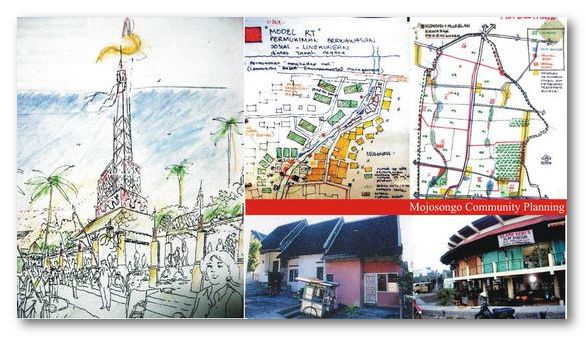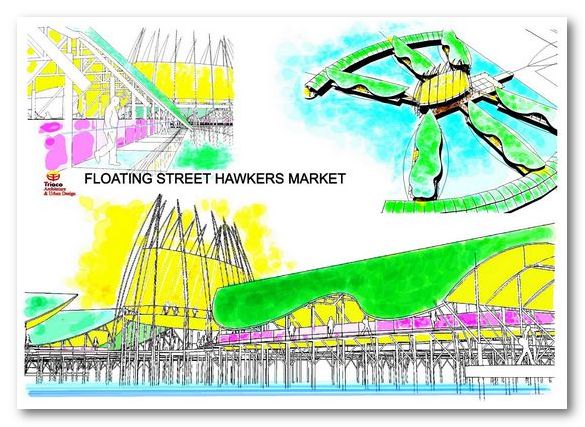Judith Mayer
The floating market draws on traditional ideas from throughout the Malay worldAntonio Ismael Risianto / TRIACO & Associates |
The catastrophic floods of 2008, which drenched Jakarta and numerous other Indonesian coastal cities, were a wake-up call to the threat that a combination of rising sea levels and badly controlled building will pose to Indonesian urban life. While estimates vary, most agree that up to 30 per cent of Jakarta’s present land area will be under water or frequently flooded by the year 2030, with similar figures for many of Indonesia’s other coastal cities.
The urban poor will be hardest hit. Their ‘informal settlements’ already fill hazard-prone margins along riverbanks and coastal floodplains.
Relocation is city bureaucrats’ conventional prescription. For the poor, this often means eviction to sprawling slums on urban fringes, far from their sources of livelihood in the informal sector of the city centre. Real estate developers with political connections promote profitable ‘redevelopment’ over conservation of flood-prone land as open space for flood mitigation. The dykes and stormwater diversions they demand to protect their new ‘flood resistant’ shopping centres, office blocks, and luxury homes divert even more runoff into poor neighbourhoods.
Architect Antonio Ismael Risianto envisions an alternative future, a hazard resistant ‘city for all’, joining social justice with sustainable design. Drawing on the Indonesian and Malay archipelago’s heritage of coastal settlement, he sees the flooding that will accompany sea level rise as a chance to reappropriate waterways and adjacent land for the urban poor. This vision turns potential disaster into opportunity for more equitable urban development – with style.
A floating mall for the poor
Antonio’s proposal to the mayor of Samarinda, East Kalimantan for a series of ‘poor people’s floating malls’ along the Mahakam River would reanimate Borneo’s tradition of riverine floating markets as flexible and egalitarian public spaces. His prototype tackles two issues for this burgeoning city: providing improved space for the hundreds of street hawkers who lack safe and sanitary facilities in convenient locations, and reducing flood hazards to the city as deforestation exacerbates extreme river flows, and rising seas carry tidal high waters to Samarinda’s shores from the Mahakam’s delta. Antonio reasons that with reliably dry land scarce in the heart of the city and prime commercial spaces already occupied, the simplest way for poor people to gain access to suitable ‘land’ for their micro-enterprises is on the water.
Antonio envisions an alternative future, a hazard resistant ‘city for all’, joining social justice with sustainable design
Floating markets would draw on waterside building techniques familiar throughout Borneo and the Malay world. Structures would be anchored with floating platforms and concrete pilings to withstand tides, floods, and high winds, but remain flexible with sturdy lightweight construction including bamboo, other local carbon-neutral materials. Unlike megastructures that wreak havoc on urban drainages, the multiple-use floating market would entail filling very little riverside land, and barely interfere with the river’s natural flow. From a landward commercial centre and nearby transport nodes, users could approach the floating mall over mobile bridges, or by boat. Agricultural produce shipped downriver would be offloaded and sold at the floating market.
Both potential users and the Samarinda officials empowered to approve floating market plans might simply scoff at Antonio’s floating mall proposal, had he not built major street credibility since the late 1980s. Antonio’s concept and design gave Samarinda Citra Niaga, a multiple-use complex that replaced a fetid squatter settlement that had taken over an abandoned public park. The Citra Niaga complex provides sanitary, affordable stalls for dry goods vendors and street food hawkers in an attractive public space that also houses larger stores, offices and shop-houses. Earnings from the better-heeled businesses helped cover costs of the hawkers’ facilities. Citra Niaga won the coveted Aga Khan award for architecture in 1989, posing a challenge to Indonesian architects and planners as a financially self-supporting redevelopment inspired to meet the needs of the poor, while also charming the city’s more prosperous citizens. Ironically, Citra Niaga has recently been eclipsed and fallen into disrepair as air conditioned shopping centres have taken over much of Samarinda’s retail business.
Barefoot architects
In a 200 hectare riverside area of Mojosongo, Solo (Central Java), Antonio’s community planning facilitation team engaged the local knowledge and resilience of Mojosongo’s low income residents to survey, plan, demolish and rebuild their own community, developing real estate and new local livelihood models on their own behalf. As an activist teacher, Antonio recruited student volunteers into Mojosongo’s redevelopment effort, imbuing them with the spirit of ‘barefoot architects’ offering their technical skills in service to the poor. The Mojosongo project was intended as a model to show local government a better path than just evicting slum dwellers and squatters by force. Mojosongo eventually combined resources from multiple international and Indonesian funders, including World Bank programs for city and regional development, for flood hazard mitigation and river cleanup.
Antonio’s own background has helped him bridge cultural gaps between the Indonesian communities he serves, a global development elite, Indonesian technocrats, and idealistic reformers
Building trust between project facilitators and the community is a keystone of participatory urban redevelopment. Facilitators convinced Mojosongo’s slum dwellers to demolish their own houses prior to building new ones with project-supported grants and loans – a huge risk in a development climate where programs often fail and leave participants in the lurch. Early trust-building exercises were also valuable ends in themselves, ‘micro actions’ to show that the Mojosongo project was no ‘NATO’ (No Action Talk Only), and to release community energy and capacity. These included organising community based garbage collection and composting, with plantings to generate income for participants; building a treatment plant for soybean waste; building a community bathroom; a tool loan program; small-scale paving block manufacture as a community business and for paving muddy alleys; participatory land measurement and surveying; and river cleanup through gotong royong (collective work).
The resulting legal riverside eco-village provides secure homes at two locations for some 220 households, sustains improved local livelihoods and cultural activities and protects a much cleaner and clearer river. Residents have not been merely project targets or recipients of government largesse. In fact, participants themselves have taken much of the risk in Mojosongo, and many parts of the process were disappointing to participants. Political and bureaucratic delays in disbursing a housing loan kept some residents living in a pig pen as temporary housing for nearly a year after they demolished their original shacks. Some new housing lacked space for drying clothes; a riverbank community gardening project was cancelled; and a ‘people’s market’ has become more of a low income supermarket than the anticipated community centre. Not surprisingly, building trust and motivating Mojosongo residents already living at the edge to take risks as part of the project rested on a classic tenet of collective action to control land. Facilitators tried to promote the local community’s willingness, as project participants, to exclude ‘new’ illegal squatters.
The UN Development Program (UNDP) selected the Mojosongo project to exemplify best practices. Indonesia’s Ministry of Human Settlements has highlighted Mojosongo as a national example for urban redevelopment programs. Participatory approaches from Mojosongo have later proved valuable in participatory ‘barefoot architect’ approaches to redevelopment in the wake of the Aceh tsunami.
Advocating redevelopment for the urban poor
 |
A new vision for Mojosongo’s slumsAntonio Ismael Risianto / TRIACO & Associates |
Antonio and his architecture and planning firm, TRIACO & Associates, are among Indonesia’s leading advocates of urban redevelopment for the poor and by the poor. TRIACO, with offices in Jakarta and Bali, focuses on action for poverty alleviation and environmental improvement. Where innovative architecture and urban design initiatives tend to follow the money, Antonio and TRIACO have had to confront head-on the tragic inequalities of urban land ownership and collusive politics. As a commercial venture, TRIACO has used earnings from private commissions and real estate ventures to underwrite action for social welfare.
The urgency of disaster relief and reconstruction has made authorities more open to innovative plans that aim to remedy urban problems rooted in processes of marginalisation that deny poor people access to urban spaces and land for homes and livelihoods. Antonio has helped deploy cadres of young barefoot architects and engineers from universities across Indonesia for disaster relief and reconstruction in post-tsunami Aceh, and in post-earthquake Yogyakarta.
Antonio’s own background has helped him bridge cultural gaps between the Indonesian communities he serves, a global development elite, Indonesian technocrats, and idealistic reformers. Antonio’s family left Indonesia in the 1960s. Born in Amsterdam, he spent his teenage years in the USA, in San Francisco’s tough multicultural Mission District as community organisers there had begun to redefine the neighbourhood’s mix of defiant immigrant cultures as a source of community strength. Antonio studied architecture across San Francisco Bay at the University of California, Berkeley, a centre of radical peoples’ design thinking at the time, followed by a postgraduate work at the Massachusetts Institute of Technology. After years in America, Antonio’s return to Indonesia with an elite professional toolbox left him unprepared for the social realities of building communities amidst prevailing poverty. But the experience gave him a mission: designing and planning high quality urban spaces for the poor, and developments that actually attack the sources of poverty through better access to urban land and livelihoods – social justice by design. ii
Judith Mayer (jmayer!@humboldt1.com) is an environmental planner in northern California, USA. Currently Coordinator of The Borneo Project of Earth Island Institute, her recent research and planning work in Indonesia has focused on community based resource management in Kalimantan. Judith holds Masters and PhD degrees in Planning, and has taught at Virginia Tech and Humboldt State University.
